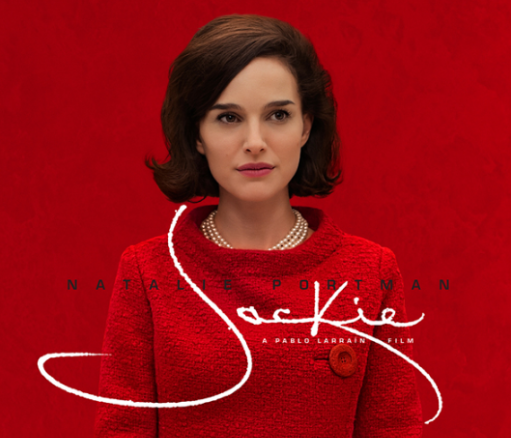
“In short, there’s simply not
A more congenial spot
For happily-ever-aftering than here
In Camelot.”
– Alan Jay Lerner
Over the past 50 years, these lyrics have become synonymous with an era in American history that few will ever forget. The Kennedy years. A young, handsome couple with adorable small children, a wife so polished and elegant as to rival the most proper British royalty, a man with ideas and initiative that looked to the stars and beyond. This was America’s own version of legend’s King Arthur. But on November 22, 1963, the dream that was the reality of a nation was shattered with the assassination of President John F. Kennedy. America watched in horror as his blood splattered, covering Jackie Kennedy’s bubblegum-pink suit as she cradled her husband’s head in her arms. And then we saw the poise and grace of this First Lady as she met the world head on, laying her husband to rest. But was happening to Jackie Kennedy behind the drawn shades of the White House? How was she coping with the grief felt by a nation, but borne by only her? How would she bend the wills of politicians to her wishes for JFK’s funeral and ultimately, how would she shape her husband’s legacy? In this uniquely and brilliantly constructed psychological character study of JACKIE set in the first days after the assassination, Chilean director Pablo Larrain tackles it all with unconventional aesthetics and non-sequential editing, all brought to life with a searing portrayal of JACKIE by Natalie Portman.

A glistening psychological stunner of an enigmatic woman who single-handedly manipulated and calculated the legacy of not only JFK, but the era of Camelot, JACKIE is also a bold character study of Jackie Kennedy told through image – both of herself and JFK – and the distinction between what is already seen through the media and what she wants to portray and put forth; told through faith; told through her marriage with flashbacks but more with dialogue and reflection, much through intimate conversation with her Priest, eloquently played by John Hurt.
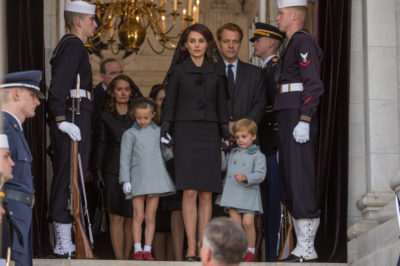
Noah Oppenheim has crafted a script that can be described most accurately as an “intelligent disarray of thoughts.” Using a bookending by way of an interview between Jackie and Billy Crudup’s “Journalist” (in reality, “Life” journalist Theodore H. White who appeared at the Kennedy compound one week after JFK’s death) as a framing device, the story is constructed with key emotional bridges, taking us into flashbacks of Jackie’s life and memories with storytelling broken into key events – the White House Tour, Dallas, the funeral, and Camelot as a whole. With an almost taunting tone, Portman’s JACKIE sets the tone for the emotional surprises that are about to unfold. On paper this approach might feel convoluted, but then toss in Larrain’s visual design and construct, plus the lensing of Stephane Fontaine, and we are mesmerized by Jackie’s eyes, and the almost excessive use of extreme close-ups, as we are pulled inside the lipid pools right into her brain at times. But even in those moments, while we feel her vulnerability and frailty, we also feel her strength and intentional personal scripting of how she will varnish and structure “the truth” for the public eye. Fascinating dichotomy. While embracing the intimacy of a woman’s most private thoughts, the hand held nature of the camera work is not only immersive, but slightly off-kilter with minute movement, akin to Jackie’s emotional state. Brilliant styling choice.
Thanks to a blend of script and lensing we are also given a very strong sense of the political tension both within the White House and Washington during the transition of power to LBJ and the balancing act of machinations that continue no matter what.

A significant sequence, both visually and editorially is the incorporation of the “A Tour of the White House with Mrs. John F. Kennedy” which originally aired on television February 14, 1962. Serving as one of the jumping off points for Jackie’s memories, as well as proving telling to some of the First Lady’s insecurities, Oppenheim pulls specific references from the television special to craft Jackie’s personal reflections, e.g., Pablo Casal’s performance at the White House, which Larrain recreates. And Larrain doesn’t just recreate references from real life, he recreates portions of the television special itself. For anyone who has seen the television special, Portman is a standout with her performance, particularly effective at capturing not only the shyness and hesitancy of JACKIE as she walks and talks through the White House, but the joy at the White House restoration project Jackie Kennedy spearheaded.
For editor Sebastian Sepulveda, “Editing these scenes of the White House Tour was fun. We jumped between the real documentary with the black and white images that they shot with Natalie Portman and then with the color [images] that was the crew and the backstage. That was the way in for the public because the public can compare the White House Tour, the real White House Tour, with the performance of Natalie Portman who was very theatrical, but Jackie was very theatrical in that White House Tour. To see the ‘backstage’ was a way to show that it was a show, that it was really a show they were doing. Greta Gerwig, the character of the assistant, was reading word by word [Jackie’s tv script] to see if [Jackie] was doing a mistake or not. Those scenes have some humor, too. And I love that. It’s very important in a film about grief, the president’s assassination, a queen without a crown, to have these moments where you can also laugh.”
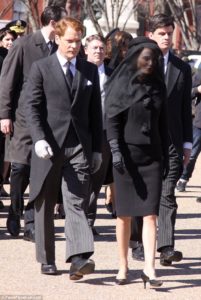
While the script is not attributed to any credited sources, at its core, it draws upon facts and images in the public domain but then takes cinematic liberties as we delve into Jackie’s mindset and cross the line of her well known fiercely guarded privacy. So well written is the character of JACKIE, and so brilliantly embodied by Natalie Portman, that even at her most vulnerable, Jackie’s strength towers above all, chameleonic in her survivalist approach to people, the press and the world, while only being truly herself and true to herself when alone. Fascinating interpretation.
The strength of Oppenheim’s written metaphor and Larrain’s visual expression is outstanding, while haunting. A perfect example is a scene in which JACKIE tells of “holding the pieces of Jack’s head together”, metaphorically equating to her own fractured psyche as we see her trying to hold her own pieces together. Simple, yet powerful.

Critical to the ebb and flow of JACKIE is the work of editor Sebastian Sepulveda, as it is the editing of specific frames taking us in and out of Jackie’s mind, much like a zoom lens that draw us ever deeper into her mind. Perhaps one of the most iconic scenes to arise in JACKIE is a montage of Jackie in a drunken pill-induced downward spiral montage. Dazzling with rich texture both visually and emotionally, Jackie’s vulnerability breaks through as we are regaled with one stunning Oleg Cassini-style fashion after another, complete with signature pieces of well known real life jewelry items, as she stumbles from room to room throughout the White House, reliving moments which, thanks to the costume design of Madeleine Fontaine and production design of Jean Rabasse, provides identifiable historic touchstones for the audience. Fontaine and Rabasse are sure to be names you will hear come Oscar Nominations morning.
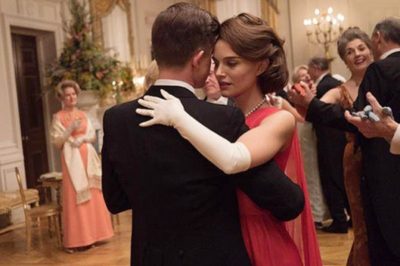
Sepulveda helps shape the narrative and putting us inside Jackie’s headspace, and not just with pacing, but with the frames chosen within the editing framework. Sepulveda snaps us in and out of reality along with Jackie thanks to hard transition cuts. According to Sepulveda, in approaching the editing design off JACKIE, he and Pablo Larrain “talked about working like this is was a mind dealing with a trauma. There were memories like fragmented pieces which were articulate in a non-linear way. But it always had to be guided by the emotional path. That was the key; not to lose the audience because the audience had to be guided by the emotion of the character.” Adding more depth to the film is that it has “four different layers of time. It’s a lot. Usually you work with two. That’s the normal thing in storytelling. For us, Oppenheim’s script was remarkable. It was excellent. It had two layers of time. It was the story of the journalist and three days after the assassination of JFK from the point of view of Jackie. That was the important thing. Pablo added two more. The White House Tour and the conversation with the priest. I think the White House Tour added something very important because now we can see her before the nightmare.”
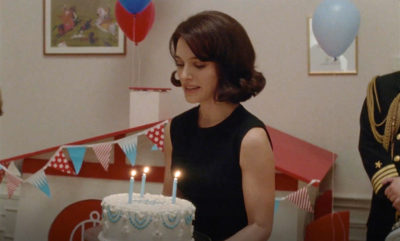
Hand-in-hand with Sepulveda’s editing is Mica Levi’s requiem-style scoring. Leaning heavily on violin and piano tinged with the hopeful playful notes of a flute, the score is haunting, yet telling and beautiful. But then punctuate that with Richard Harris’ singing Lerner & Loewe, delivering the dream of Camelot, Jackie’s singularly created enduring legacy of JFK’s presidency soars.
This is the performance of lifetime by Natalie Portman. As great as she was in “Black Swan”, as JACKIE, she surpasses her own level of excellence. Expect to hear her name announced come Oscar nominations morning. Her skill set as an actress is even stronger now and it shows with every move, every look, every utterance. Vocally, while she alters her voice in cadence and tone to capture the essence of Jackie Kennedy’s own voice, it never becomes an imitation, but rather draws us ever closer to this woman.
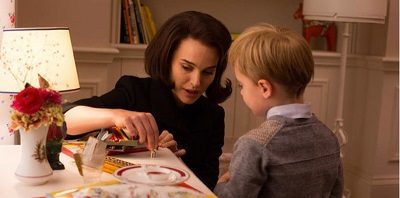
Peter Sarsgaard is, as usual, brilliant with not only his portrayal of Robert F. Kennedy, but his chemistry with Portman is resonant and in keeping with what is long embedded in the public consciousness based on a lifetime of interviews from various Kennedys talking about RFK and then Ted Kennedy as being the rocks for the children and widows as the brothers were killed. Every moment between the two feels authentic and familiar as Bobby and Jackie battle the political demons of funeral protocol while Jackie tacitly sees the situation as an opportunity to cement her husband’s legacy. A testament to Oppenheim, Larrain and Portman, in these battleground moments we see the obliviousness of all to Jackie’s personal loss, something that drives not only Portman’s performance, but the dynamic between Portman and Sarsgaard.
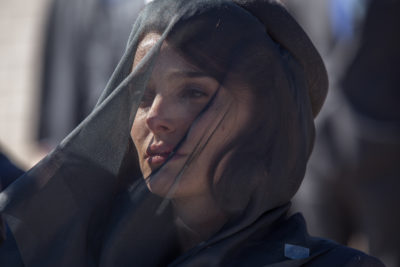
Expanding on the dynamic between Portman and Sarsgaard, and the depth of emotional nuance permeating every fiber of JACKIE, is the friendship we see between Jackie and her seeming only friend in the White House, her aide Nancy Tuckerman. A casting surprise is Gerwig who plays Nancy Tuckerman. While already known as being a good actress, this is a very controlled, subdued performance which stands out thanks to an ever-present look of wide-eyed care and concern.
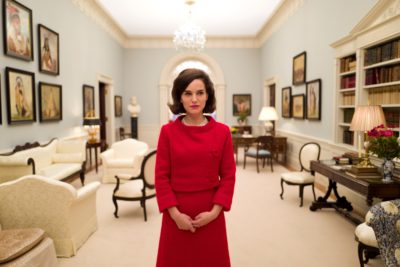
Not to be overlooked are Beth Grant and John Carroll Lynch as Lady Bird and Lyndon B. Johnson. Striking and subtle work from both.
To borrow words from John F. Kennedy himself when speaking about Jackie’s work during “The White House Tour”, “I think the great effort she has made is to bring us much more intimately in contact with all the men who lived here. History is people. . . Anything which dramatizes the great story of the United States, [what] I think the White House does, is worthy of the closest attention and respect by Americans who live here and visit here.” The same can be said about Jackie Kennedy and Pablo Larrain’s JACKIE. While her story may be dramatized, Larrain has more intimately connected all of us to not only Jackie Kennedy and a time of innocence and its loss, but that happily-ever-aftering of Camelot.
Directed by Pablo Larrain
Written by Noah Oppenheim
Cast: Natalie Portman, Peter Sarsgaard, Billy Crudup, Greta Gerwig, John Hurt











